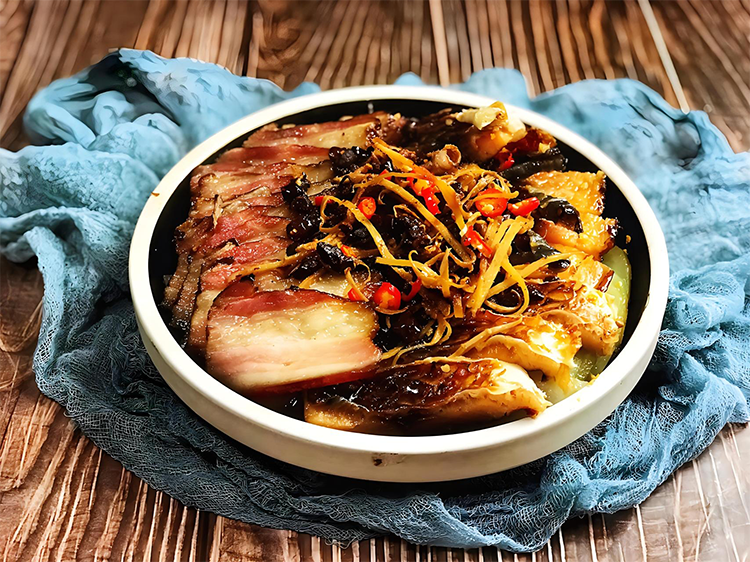Hunan Steamed Cured Meats: Smoky Flavor of XiangCuisine
As you stroll through the stone lanes of Phoenix Ancient Town or linger at a street stall on Changsha’s Pozi Street, a distinctive smoky aroma may suddenly tempt your senses — that’s the soul of Hunan cured meats. Among these specialties, Lawei Hezheng (腊味合蒸) stands out: a steamed platter of cured pork, chicken, and smoked fish that blends time-honored preservation with Xiang cuisine’s bold flavors. This article unveils its history, cultural meaning, ingredients, cooking process, and tasting tips for travelers.
1. Origin and History: From Household Preservation to Banquet Centerpiece
Lawei Hezheng originated from Hunan’s need to preserve meat in a humid climate without refrigeration. Smoking and air-drying became essential methods. Records indicate that curing techniques existed as early as the Han dynasty. The tradition of steaming several cured items together started in family kitchens before the Lunar New Year, when households would hang cured pork, chicken, and fish near the hearth.
For convenience, these meats were sliced and steamed together for the holiday meal. The steaming process allowed fats and smoky aromas to mingle, producing a rich, complex flavor unmatched by cooking each item separately.
Later, chefs refined the home-style recipe for restaurants by adding chicken stock and seasonings such as fermented black beans and dried chili. Over time, Lawei Hezheng evolved into a celebrated banquet dish that embodies the soul of Xiang cuisine.

2. Cultural Meaning: Reunion, Hospitality, and Homesickness
In Hunan, Lawei Hezheng symbolizes reunion and abundance. A single platter unites land and water — poultry, pork, and fish — representing prosperity and family togetherness. Offering such a hearty dish has long been a gesture of hospitality and respect for guests.
The dish also carries a deep sense of nostalgia. For Hunan people living far from home, the smoky aroma evokes memories of kitchens, family gatherings, and childhood comfort. Eating Lawei Hezheng becomes not just a meal, but a warm reconnection with home and tradition.
3. Ingredients and the Art of Timing
Authentic Lawei Hezheng depends on high-quality cured ingredients, typically including:
- Cured pork (balanced fat and lean meat)
- Cured chicken or duck (firm texture)
- Cured fish (often grass carp or black carp)
These are produced through salting, air-drying, and smoking — a process that can take weeks to achieve the signature smoky, savory flavor.
Preparation steps:
- Pre-treat: Rinse the cured meats in warm water, trim off overly smoky surfaces, then briefly simmer or steam to soften for slicing.
- Slice and layer: Cut evenly and arrange in a bowl with fattier cuts at the bottom so their oils drip through during steaming.
- Season and steam: Add a bit of chicken stock, fermented black beans, dried chili, and a touch of sugar. Steam on high for 30–40 minutes until the meats turn tender and aromatic.

4. Flavor Profile and How to Enjoy It
A well-made Lawei Hezheng glistens with reddish tones and an irresistible smoky aroma.
Taste notes:
- Cured pork: Amber-hued fat that melts in the mouth; lean parts are savory and pleasantly chewy.
- Cured chicken/duck: Firm, richly smoked, and full-bodied.
- Cured fish: Flaky and salty-savory, with a smoky note that ties everything together.
Best pairings:
- Steamed white rice: The rich juices soak into the rice, making it deeply satisfying.
- Beer or Shaoxing-style yellow wine: Ideal for sharing among friends.
Since cured meats are already salty, extra seasoning is unnecessary — let the natural smoky layers shine.
5. Where and When to Taste — Traveler Tips
Best season: Autumn and winter, especially during the Lunar New Year when cured meats are freshly made.
Where to try:
- High-end restaurants: Found in Changsha, Xiangtan, and other Hunan cities, offering refined versions.
- Local eateries and homestays: In Phoenix Ancient Town or Furong Town, you’ll find rustic, traditionally smoked versions.
Ordering tips:
- Ask for less chili if you prefer mild flavors.
- Pair with clear vegetable soup or stir-fried greens to balance the richness.
- If sensitive to salt, enjoy with plenty of rice and vegetables.

6. Simple Home Version for Travelers
Missing the taste after your trip? Try a simple Lawei Hezheng at home using vacuum-packed Hunan cured pork, sausage, and smoked fish:
- Rinse and steam the cured items for 10 minutes to soften.
- Slice and arrange in a deep dish with a few fermented black beans and dried chili.
- Add 1 tbsp rice wine, ½ tbsp neutral oil or chicken stock, and a pinch of sugar.
- Steam on high for 20–25 minutes. Serve with rice and enjoy!

7. Conclusion
Lawei Hezheng, Hunan’s steamed cured-meat platter, is a mouthwatering expression of preservation wisdom and Xiang culinary artistry. Its smoky aroma, balanced saltiness, and rich texture reveal Hunan’s bold food culture and warm hospitality.
When visiting Hunan, don’t miss this comforting dish — one bite connects you to the region’s history, family traditions, and the shared joy of a hearty meal.


